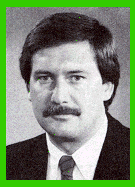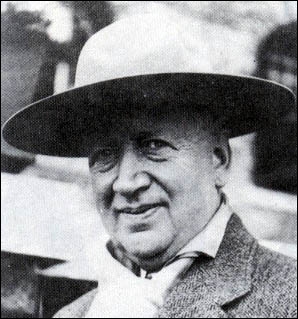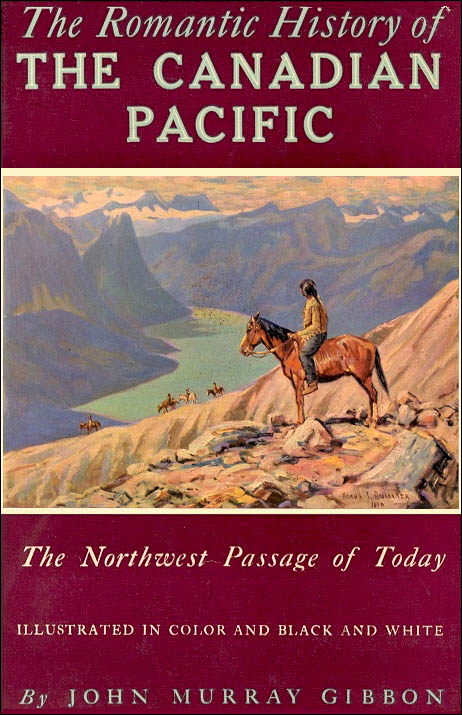Vol. 18 No. 11
December 1988/January 1989
|
Safety - Priority #1
|

CPR's Gibbon
Celebrated
"Mosaic"
|

Dave Jones
|

John Murray
Gibbon - Date/photographer unknown.
The renowned CPR publicist, John Murray Gibbon, was one of the first to
characterize the Canadian identity as a "mosaic" of cultures.
Unlike the American "melting pot", the Canadian ideal has been less homogeneous and more appreciative of
the righ traditions that have been brought over to this country from abroad.
This diversity was celebrated by Gibbon in a variety of writings, both descriptive and lyrical.
Works such as "Canadian Folksongs Old and New" and "New World Ballads" were compilations of traditional
French Canadian songs, rewritten in English to promote a better understanding of the "French Canadian character".
Bu Gibbon was not one to pursue his interests from just one direction. Much of the material for his books was assembled
as a result of his involvement with the British folksong revivalists.

Cover jacket to his
book "The Romantic History of the Canadian Pacific".
The Romantic History of the Canadian Pacific
Gibbon, John Murray
Tudor Publishing Co. 6 Eastham Village Rd. Eastham Wirral Merseyside UK L62 8AD
1937 - Hard cover
6.5 x 9.5 inches - 16.5 x 24 centimetres
433 pages, 133 photos, 14 drawings, 12 maps
$25.00 (many years ago)
Also known as "Steel of Empire". The book is pro CPR but excellent
nevertheless.
His position as general publicity agent for the CPR, under the supportive presidency of Edward Beatty, provided the
ideal opportunity for gibbon to promote the ethnic tradituons of Canadians while showcasing the company's facilities across the country.
During the years 1927 through 1930, he orchestrated a series of folksong and handicraft festivals at the major CPR hotels,
offering programs of entertainment tailored to the settings and the origins of the people in the regions.
the first of these events was held at the Chateau Frontenac in Quebec City in May, 1927. although it was financed by the
CPR, the National Museum of Candad agreed to be co-sponsor and loaned a number of Huron Indian artifacts to the handicrafts
exhibits.
Festival-goers were treated to an incredible variety of folklore through such means as the songs of
fishermen from the Gaspe, who sang as they mended their nets; religious songs of the Hurons from Ancienne Lorette, taught to their forefathers
by Jesuit missionaries; songs of the lumberjacks and river men, which accompanied a hard-working day; and songs of wives and
daughters from the villages, who sang as they spun cloth and hooked rugs.
Special Canadian Pacific trains brought in loads of visitors, and the main events, which were staged in the Chateau's
ballroom were standing-room-only, sold out events.
At the Banff Springs "Highland Gathering and Scottish Music Festival", the usual games and highland dances
were enlivened by the presence of pipers from each of the Highland Regiments in Canada.
The first year's program included such exotic fare as an oper air church service in Sun Dance Canyon, and a musical porgram
which included "two concerts of Scotch (sic) music arangied in historical sequence, commencing with thirteenth century ballads in Gaelic
and in Lowland Scottish dialect, followed by a group of songs of the period of Mary Queen of Scots".
Soon the popularity of these festivals justified additional engagements. The "New Canadian Folk Song and Handicraft Festival"
was held at the royal Alexandra Hotel in Winnipeg; the "Great West Canadian Folk Song, Folk Dance and Handicrafts Festival" was organized
at the Hotel Saskatchewan in Regina one yar and at the Palliser in Calgary another; the "Sea Music Festival" and the "Old
English Yuletide Festival" were staged at the Vancouver Hotel and the Empress Hotel in Victoria respectively; and the "English
Music Festival" was presented at the Royal York in Toronto.
Supplementing the musical programs at all of these gatherings, were demonstrations of craft work presented by the Canadian
Handicraft Guild, and organization which Gibbon also had had a hand in establishing.
Often a representative selection of Canadian fine art was assembled, adding to the wide scope and attraction of the festivals.
The National Gallery was encouraged to participate in this regard, and loaned paintings from its collection on more than one occasion.
Although the public invariably gave the festivals a warm reception, and, in fact, often lost their restraint in calling for
encores during the musical performances, the press was sometimes uncertain what to make of all the goings-on.
While the general consensus in Quebec was that the festivals were positive vehicles for promoting the traditions of rural
society in the province, the Western Canadian newspapers showed much more ambivalence in their coverage.
In an interesting entry from the Winnipeg Free Press, describing the 1928 gathering at the Royal Alex, this attitude is
clear:
"Blazing in colours, the hotel rotunda presents a motley scene. Garbed in seemingly grotesque clothes of many bright
hues, the European mingles with the conservatively-clad westerner. The new Canadian seems perfectly at home in this setting,
for it is that of his native land. But the Westerner is bewildered, there are many things that arrouses his interest".
The onset of the Great Depression of the 1930s, and the attendant halt in immigration, put an end to the great extravaganzas
at the CPR hotels, but Gibbon stayed very much involved in promoting ethnic cultures through his writings and through a new medium, company sponsored
radio shows.
A Profile of John Murray Gibbon by Dave Jones.
This CP Rail News article is copyright
1989 by the Canadian Pacific Railway and is reprinted here
with their permission. All photographs, logos, and trademarks are the property of the Canadian Pacific Railway
Company.
|
|